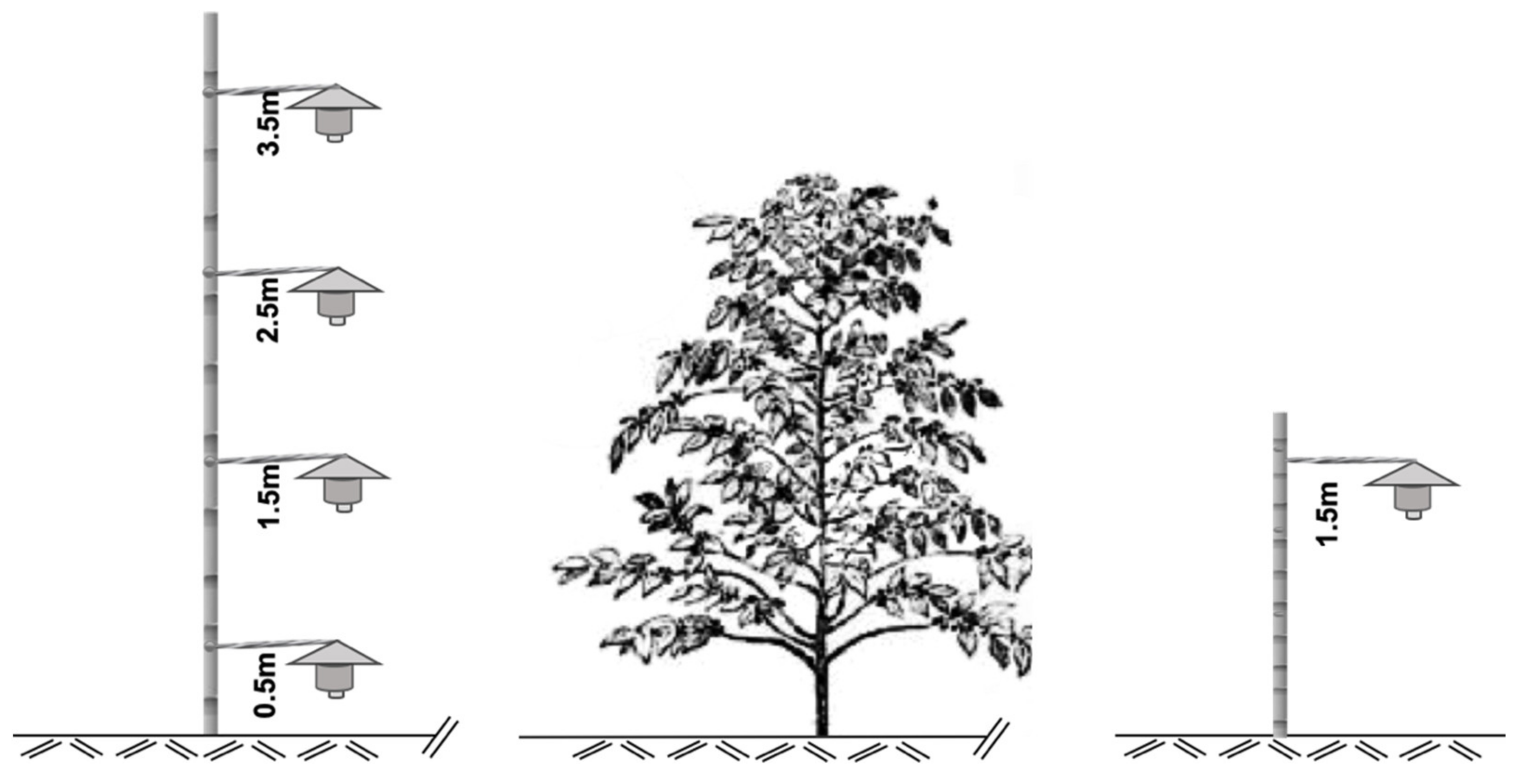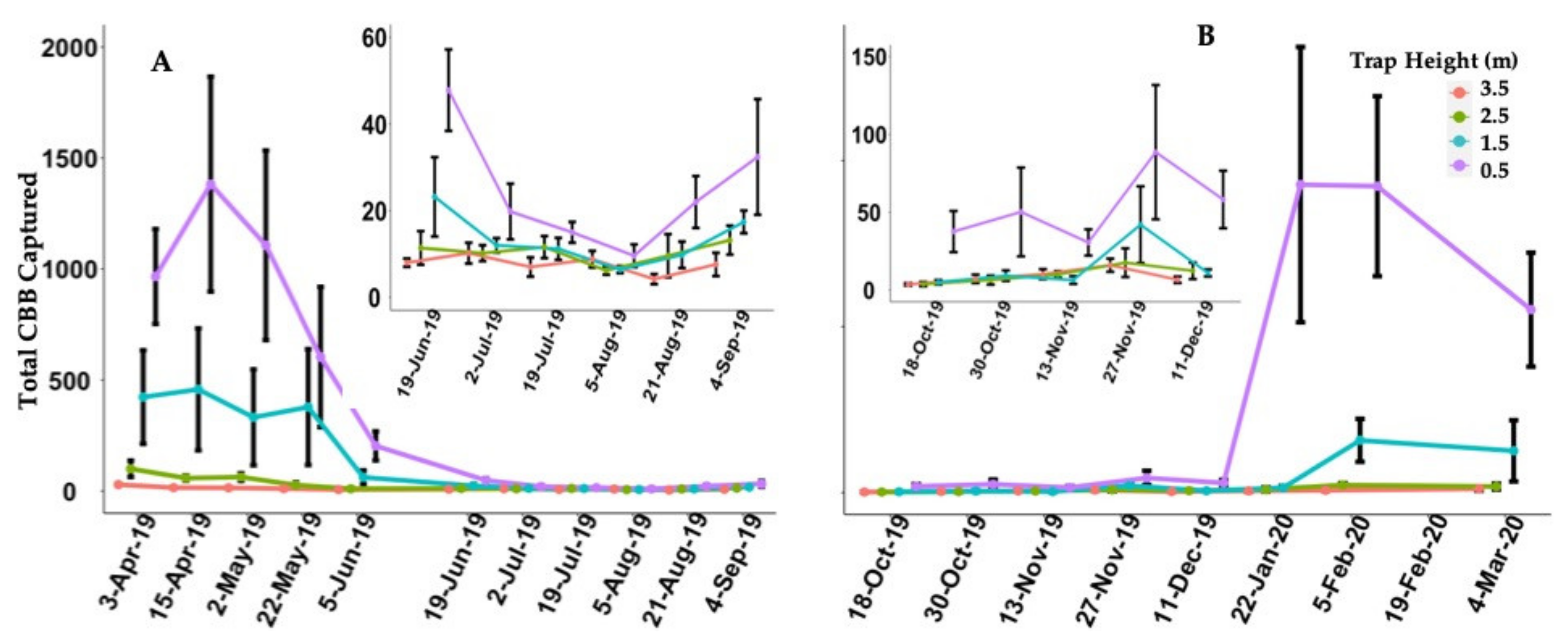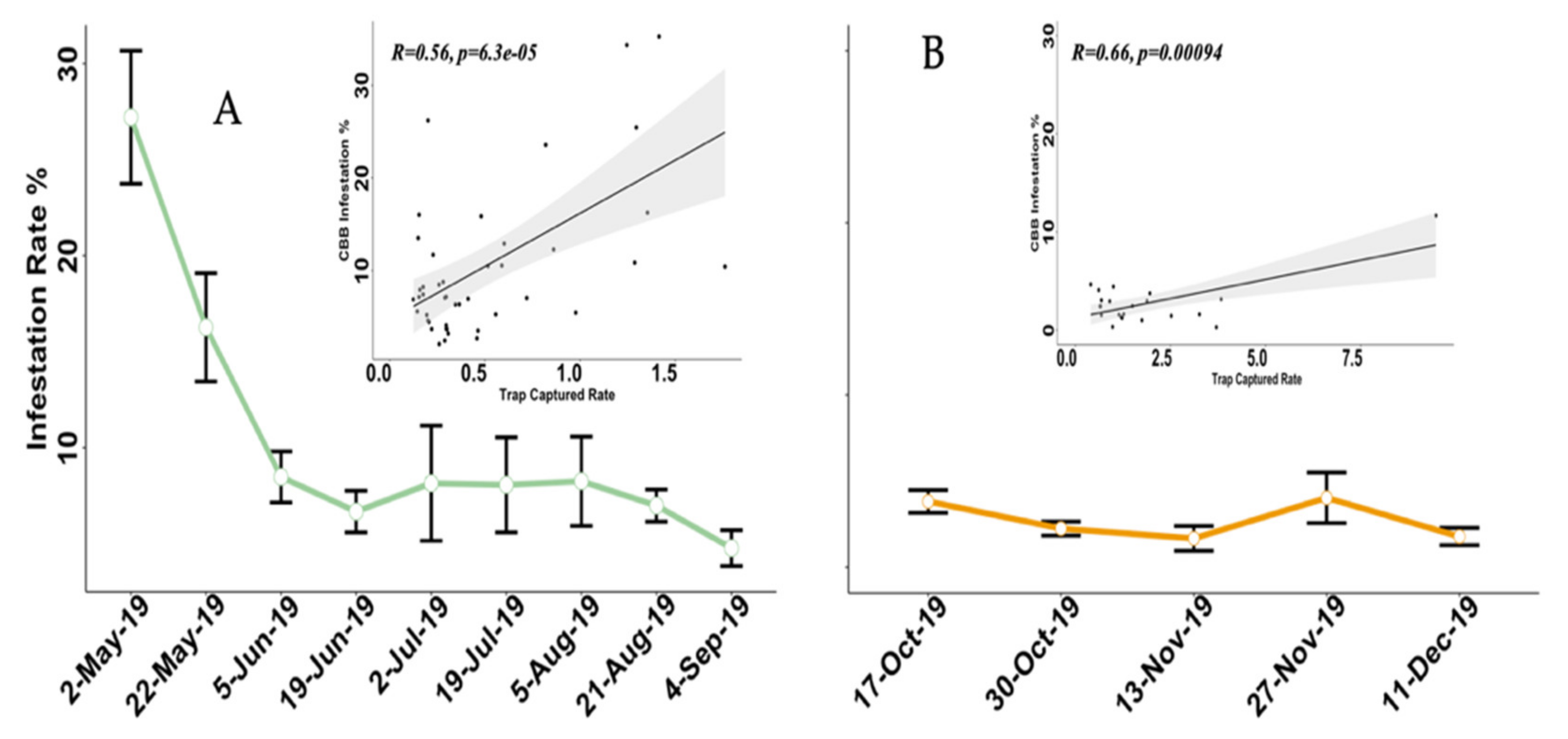Vertical Trapping of the Coffee Berry Borer, Hypothenemus hampei (Coleoptera: Scolytinae), in Coffee
Abstract
:Simple Summary
Abstract
1. Introduction
2. Materials and Methods
2.1. Study Sites
2.2. Column Trap Designed
2.3. Data Collection
2.4. Data Analysis
3. Results
4. Discussion
5. Conclusions
Supplementary Materials
Author Contributions
Funding
Acknowledgments
Conflicts of Interest
References
- Damon, A. A review of the biology and control of the coffee berry borer, Hypothenemus hampei (Coleoptera: Scolytidae). Bull. Entomol. Res. 2000, 90, 453–465. [Google Scholar] [CrossRef] [PubMed] [Green Version]
- Johnson, M.A.; Ruiz-Diaz, C.P.; Manoukis, N.C.; Rodrigues, J.C.V. Coffee berry borer (Hypothenemus hampei), a global pest of coffee: Perspectives from historical and recent invasions, and future priorities. Insects 2020, 11, 882. [Google Scholar] [CrossRef] [PubMed]
- Mathieu, F.; Brun, L.O.; Marchillaud, C.; Frérot, B. Trapping of the coffee berry borer Hypothenemus hampei Ferr. (Col., Scolytidae) within a mesh-enclosed environment: Interaction of olfactory and visual stimuli. J. Appl. Ent. 1997, 186, 181–186. [Google Scholar] [CrossRef]
- Bustillo, A.E.; Cárdenas, R.; Villalba, D.A.; Benavides, P.; Orozco, J. Implantación del Manejo Integrado de la Broca del café Hypothenemus Hampei (Ferrari) en Colombia; Centro Nacional de Investigaciones de Café ‘Pedro Uribe Mejía’: Brocarta, Colombia, 1998; 134p. [Google Scholar]
- Mathieu, F.; Brun, L.O.; Frerot, B.; Suckling, D.F.C. Progression in field infestation is linked with trapping of coffee berry borer, Hypothenemus hampei (Col., Scolytidae). J. Appl. Entomol. 1999, 123, 424–429. [Google Scholar] [CrossRef]
- Barrera, J.; Infante, F.; Rosa, W.; Castillo, A.; Gómez, J. Control biológico de la broca del café. In Fundamentos y Perspectiva del Control Biológico; Badii, M.H., Flores, A., Galán, L., Eds.; Universidad Autónoma de Nuevo México: Nuevo León, México, 2000; Volume 1, pp. 211–229. [Google Scholar]
- Messing, R.H. The coffee berry borer (Hypothenemus hampei) invades Hawaii: Preliminary investigations on trap response and alternate hosts. Insects 2012, 3, 640–652. [Google Scholar] [CrossRef] [PubMed] [Green Version]
- Aristizábal, L.F.; Shriner, S.; Hollingsworth, R.; Arthurs, S.A. Flight activity and field infestation relationships for coffee berry borer in commercial coffee plantations in Kona and Kau Districts, Hawaii. J. Econ. Entomol. 2017, 110, 2421–2427. [Google Scholar] [CrossRef] [PubMed]
- Baker, P. The Coffee Berry Borer in Colombia. Final Report of the DFID-Cenicafé-CABI Bioscience IPM for Coffee Project; Cenicafe: Caldas, Colombia, 1999. [Google Scholar]
- Barrera Juan, F.; Villacorta, A.; Herrera, J. Fluctuación estacional de las capturas de la broca del café (Hypothenemus hampei) con trampas de Etanol—Metanol e implicaciones sobre el número de trampas. Entomol. Mex. 2004, 3, 540–544. [Google Scholar]
- Jaramillo, J.; Borgemeister, C.; Baker, P. Coffee berry borer Hypothenemus hampei (Coleoptera: Curculionidae): Searching for sustainable control strategies. Bull. Entomol. Res. 2006, 96, 223–233. [Google Scholar] [CrossRef] [PubMed] [Green Version]
- Vega, F.E.; Franqui, R.A.; Benavides, P. The presence of the coffee berry borer, Hypothenemus hampei, in Puerto Rico: Fact or fiction? J. Insect Sci. 2002, 2, 1–3. [Google Scholar] [CrossRef]
- Wiryadiputra, S.; Cilas, C.; Morin, J.P. The effectiveness of Brocap trap to control coffee berry borer (Hypothenemus hampei Ferr.) in Indonesia. In Proceedings of the 22nd International Conference on Coffee Science, Campinas, SP, Brazil, 14–19 September 2008. [Google Scholar]
- Dufour, B.P.; González, M.O.; Mauricio, J.J.; Chávez, B.A.; Amador, R. Validación del trampeo de la broca del café con la trampa Brocap. XX Simposio Latinoamericano de Caficultura, San Pedro Sula, Honduras, 20 May 2003. [Google Scholar]
- Barrera, J.F.; Mora, V.; Franciscocoaut, J. Efecto de la altura de la trampa en la captura de la “Broca del Café”: Implicaciones en dispersión y muestreo. Entomol. Mex. 2005, 4, 542–546. [Google Scholar]
- Pereira, A.E.; Vilela, E.F.; Tinoco, R.S.; de Lima, J.O.G.; Fantine, A.K.; Elisângela, G.F.; Christiane, F.; França, F. Correlation between numbers captured and infestation levels of the coffee berry-borer, Hypothenemus hampei: A preliminary basis for an action threshold using baited traps. Int. J. Pest Manag. 2012, 58, 175–179. [Google Scholar] [CrossRef] [Green Version]
- Castro, A.M.; Tapias, J.; Ortiz, A.; Benavides, P.; Gongora, C. Identification of attractant and repellent plants to coffee berry borer, Hypothenemus hampei. Entomol. Exp. Appl. 2017, 164, 120–130. [Google Scholar] [CrossRef]
- Barrera, J.F.; Herrera, J.; Amador, V.; Heber, G.; Leopoldo, C. Trampas de metanol-etanol para detección, monitoreo y control de la broca del café Hypothenemus hampei. In Simposio Sobre Trampas y Atrayentes en Detección, Monitoreo y Control de Plagas de Importancia; Chiapas México; El Colegio de la Frontera Sur: Colima, México, 2006; pp. 71–83. [Google Scholar]
- Johnson, M.A.; Hollingsworth, R.; Fortna, S.; Aristizábal, L.F.; Manoukis, N.C. The Hawaii protocol for scientific monitoring of coffee berry borer: A model for coffee agroecosystems worldwide. J. Vis. Exp. 2018, 2018, 1–8. [Google Scholar] [CrossRef] [PubMed] [Green Version]
- Uemura-Lima, D.H.; Ventura, M.U.; Mikami, A.Y.; da Silva, F.C.; Morales, L. Responses of coffee berry borer, Hypothenemus hampei (Ferrari) (Coleoptera: Scolytidae), to vertical distribution of methanol: Ethanol traps. Neotrop. Entomol. 2010, 39, 930–933. [Google Scholar] [CrossRef] [PubMed] [Green Version]
- Warton, D.; Hui, F. The arcsine is asinine: The analysis of proportions in ecology. Ecology 2011, 92, 348–354. [Google Scholar] [CrossRef] [PubMed] [Green Version]
- R Core Team. R: A language and environment for statistical computing. R Found. Stat. Comput. 2014. Available online: http://www.R-project.org/ (accessed on 1 July 2021).
- R Studio Team. RStudio: Integrated Development for, R. RStudio 2015. Available online: http://www.rstudio.com/ (accessed on 8 May 2018).
- Wickham, H. Ggplot2: Elegant Graphics for Data Analysis; Springer: New York, NY, USA, 2009; 182p. [Google Scholar]
- Venables, W.N.; Ripley, B.D. Modern Applied Statistics with S, 4th ed.; Springer: New York, NY, USA, 2002; ISBN 0-387-95457-0. Available online: https://www.stats.ox.ac.uk/pub/MASS4/ (accessed on 15 July 2020).
- Mariño, Y.A.; Vega, V.J.; García, J.M.; Rodrigues, J.C.V.; García, N.M.; Bayman, P. The coffee berry borer (Coleoptera: Curculionidae) in Puerto Rico: Distribution, infestation, and population per fruit. J. Insect Sci. 2017, 17, 1–8. [Google Scholar] [CrossRef] [PubMed] [Green Version]




| Experiment A | ||||||||||
|---|---|---|---|---|---|---|---|---|---|---|
| Date | Temp °C | Max | Min | RH% | Max | Min | R | RE | DD | CBB |
| 3-Apr.-19 | 20.7 ± 4.4 | 30.5 | 12.1 | 85.1 | 100 | 44.7 | 52.0 | 11 | 8 | 7588 |
| 15-Apr.-19 | 20.8 ± 4.3 | 30.6 | 12.3 | 83.8 | 100 | 42.4 | 10.4 | 14 | 3 | 9563 |
| 2-May-19 | 21.2 ± 4.5 | 31.4 | 12.6 | 85.1 | 100 | 44.7 | 95.6 | 20 | 7 | 7577 |
| 22-May-19 | 22.2 ± 4.2 | 31.5 | 13.8 | 85.1 | 100 | 55.1 | 144.0 | 13 | 9 | 5092 |
| 5-Jun.-19 | 22.2 ± 3.6 | 31.3 | 16.1 | 89.1 | 100 | 55.6 | 84.6 | 29 | 13 | 1406 |
| 19-Jun.-19 | 23.2 ± 4.4 | 33.9 | 15.3 | 85.8 | 100 | 53.5 | 17.4 | 12 | 8 | 452 |
| 2-Jul.-19 | 23.5 ± 4.3 | 33.0 | 15.9 | 85.5 | 100 | 50.7 | 52.8 | 8 | 7 | 261 |
| 19-Jul.-19 | 23.0 ± 3.7 | 32.1 | 15.3 | 87.2 | 100 | 49.8 | 222.6 | 28 | 6 | 224 |
| 5-Aug.-19 | 23.5 ± 3.8 | 32.4 | 16.0 | 87.8 | 100 | 46.9 | 40.0 | 19 | 5 | 155 |
| 21-Aug.-19 | 23.7 ± 3.9 | 32.2 | 16.0 | 86.7 | 100 | 54.4 | 78.6 | 17 | 7 | 228 |
| 4-Sep.-19 | 23.5 ± 4.4 | 33.7 | 15.0 | 86.2 | 100 | 45.8 | 20.4 | 10 | 4 | 353 |
| Mean ± SD | 22.5 ± 4.1 | 32.1 | 14.6 | 86.1 | 100.0 | 49.4 | 818.4 | 181.0 | 77.0 | 32,899.0 |
| Experiment B | ||||||||||
| 18-Oct.-19 | 21.8 ± 4.6 | 32.9 | 14.7 | 89.9 | 43.9 | 100 | 270.4 | 32 | 3 | 250 |
| 30-Oct.-19 | 22.0 ± 3.7 | 30.9 | 16.1 | 91.7 | 50.2 | 100 | 75.0 | 28 | 1 | 365 |
| 13-Nov.-19 | 21.9 ± 3.8 | 29.7 | 15.8 | 90.1 | 57.2 | 100 | 89.8 | 16 | 4 | 286 |
| 27-Nov.-19 | 20.9 ± 3.9 | 30.3 | 13.8 | 92.0 | 58.4 | 100 | 103.2 | 19 | 6 | 821 |
| 11-Dec.-19 | 21.1 ± 3.8 | 29.6 | 13.5 | 90.9 | 56.3 | 100 | 30.0 | 18 | 1 | 441 |
| 22-Jan.-20 | 20.8 ± 3.3 | 29.3 | 13.6 | 90.0 | 53.8 | 100 | 111.2 | 77 | 16 | 9574 |
| 5-Feb.-20 | 20 ± 4.2 | 29.7 | 12.2 | 91.5 | 50.1 | 100 | 79.2 | 24 | 4 | 11101 |
| 19-Feb.-20 | 21.6 ± 3.8 | 29.4 | 13.3 | 90.5 | 55.1 | 100 | 12.4 | 12 | 6 | 9368 |
| 4-Mar.-20 | 20.3 ± 4.1 | 29.7 | 12.7 | 89.1 | 42.2 | 100 | 95.4 | 30 | 6 | 7067 |
| Mean ± SD | 21.2 ± 3.9 | 30.2 | 14.0 | 90.6 | 51.9 | 100.0 | 866.6 | 256.0 | 47.0 | 39,273.0 |
Publisher’s Note: MDPI stays neutral with regard to jurisdictional claims in published maps and institutional affiliations. |
© 2021 by the authors. Licensee MDPI, Basel, Switzerland. This article is an open access article distributed under the terms and conditions of the Creative Commons Attribution (CC BY) license (https://creativecommons.org/licenses/by/4.0/).
Share and Cite
Ruiz-Diaz, C.P.; Rodrigues, J.C.V. Vertical Trapping of the Coffee Berry Borer, Hypothenemus hampei (Coleoptera: Scolytinae), in Coffee. Insects 2021, 12, 607. https://doi.org/10.3390/insects12070607
Ruiz-Diaz CP, Rodrigues JCV. Vertical Trapping of the Coffee Berry Borer, Hypothenemus hampei (Coleoptera: Scolytinae), in Coffee. Insects. 2021; 12(7):607. https://doi.org/10.3390/insects12070607
Chicago/Turabian StyleRuiz-Diaz, Claudia Patricia, and José Carlos Verle Rodrigues. 2021. "Vertical Trapping of the Coffee Berry Borer, Hypothenemus hampei (Coleoptera: Scolytinae), in Coffee" Insects 12, no. 7: 607. https://doi.org/10.3390/insects12070607
APA StyleRuiz-Diaz, C. P., & Rodrigues, J. C. V. (2021). Vertical Trapping of the Coffee Berry Borer, Hypothenemus hampei (Coleoptera: Scolytinae), in Coffee. Insects, 12(7), 607. https://doi.org/10.3390/insects12070607







